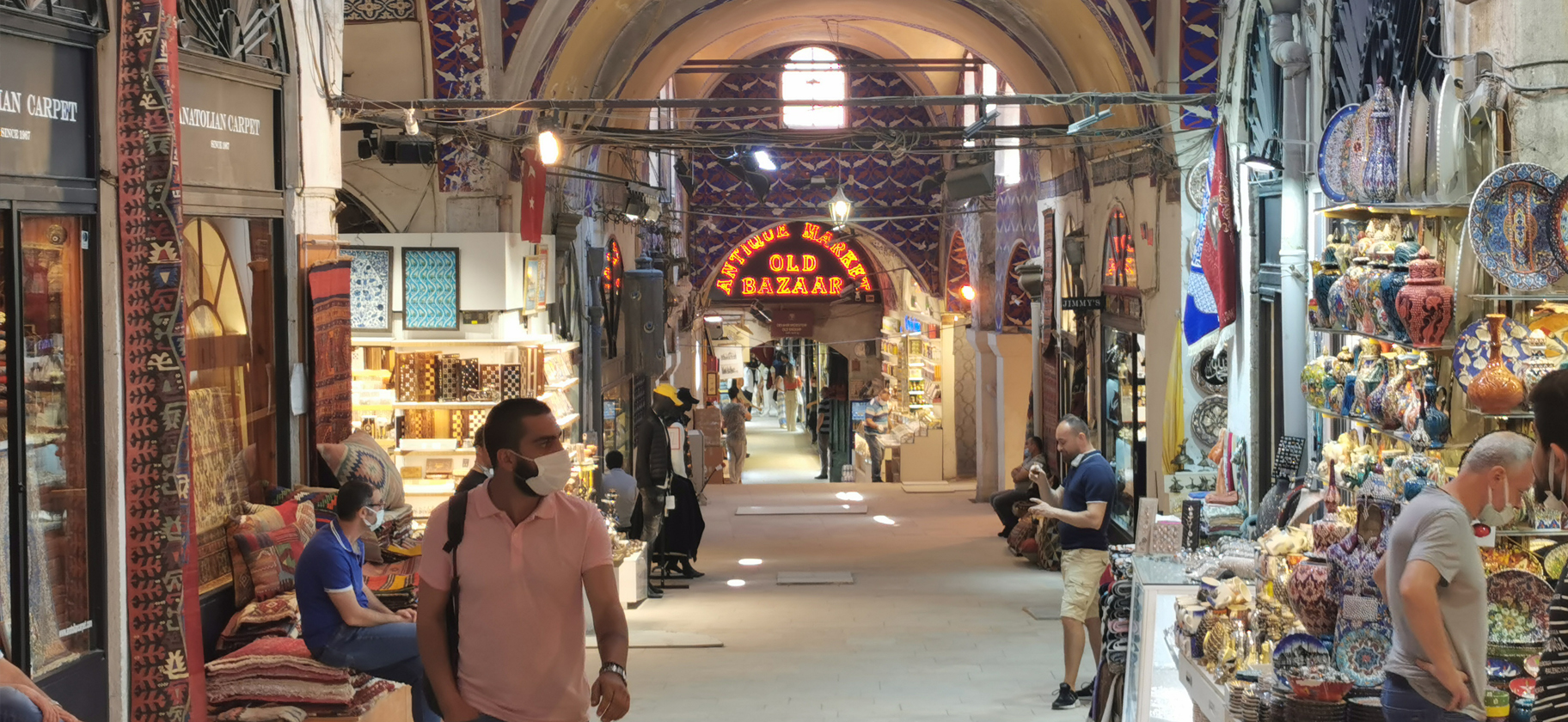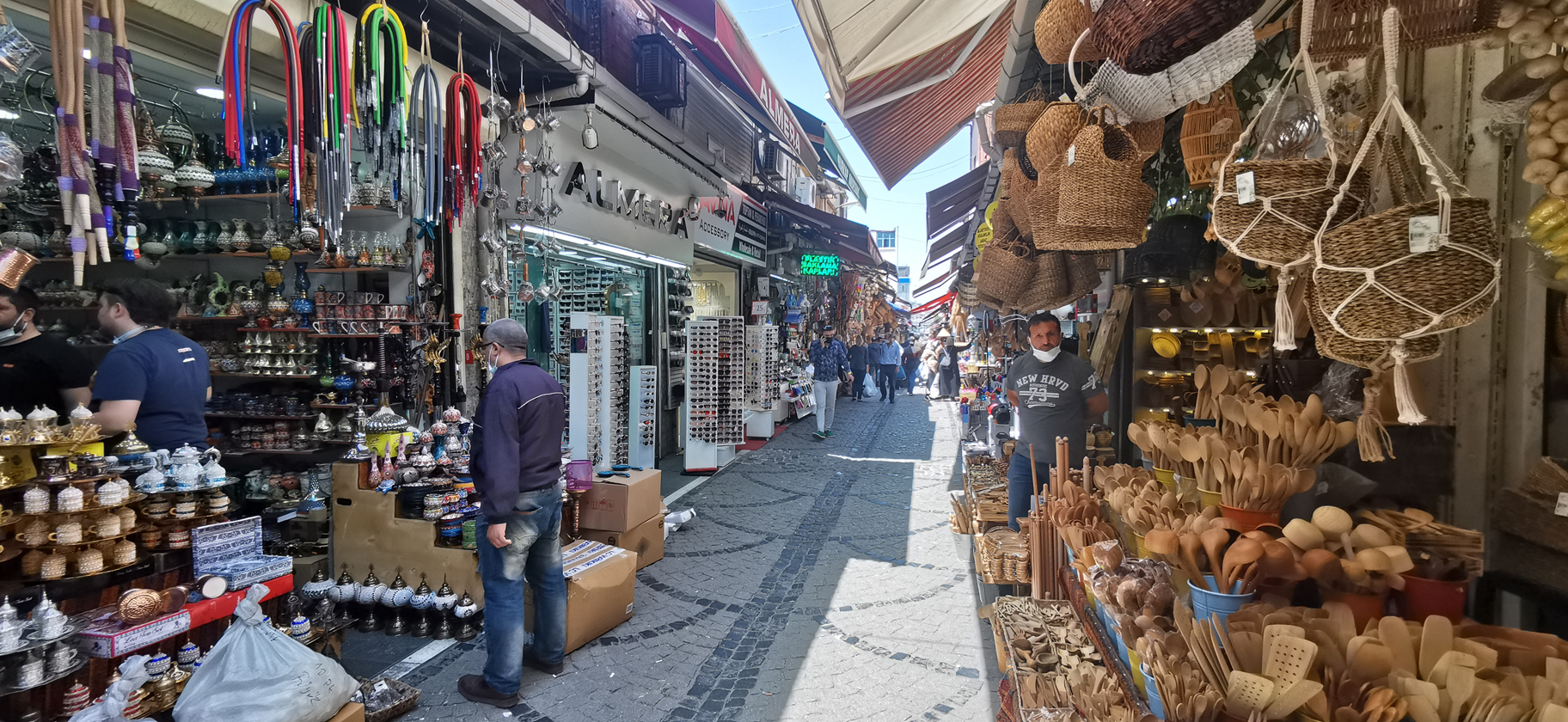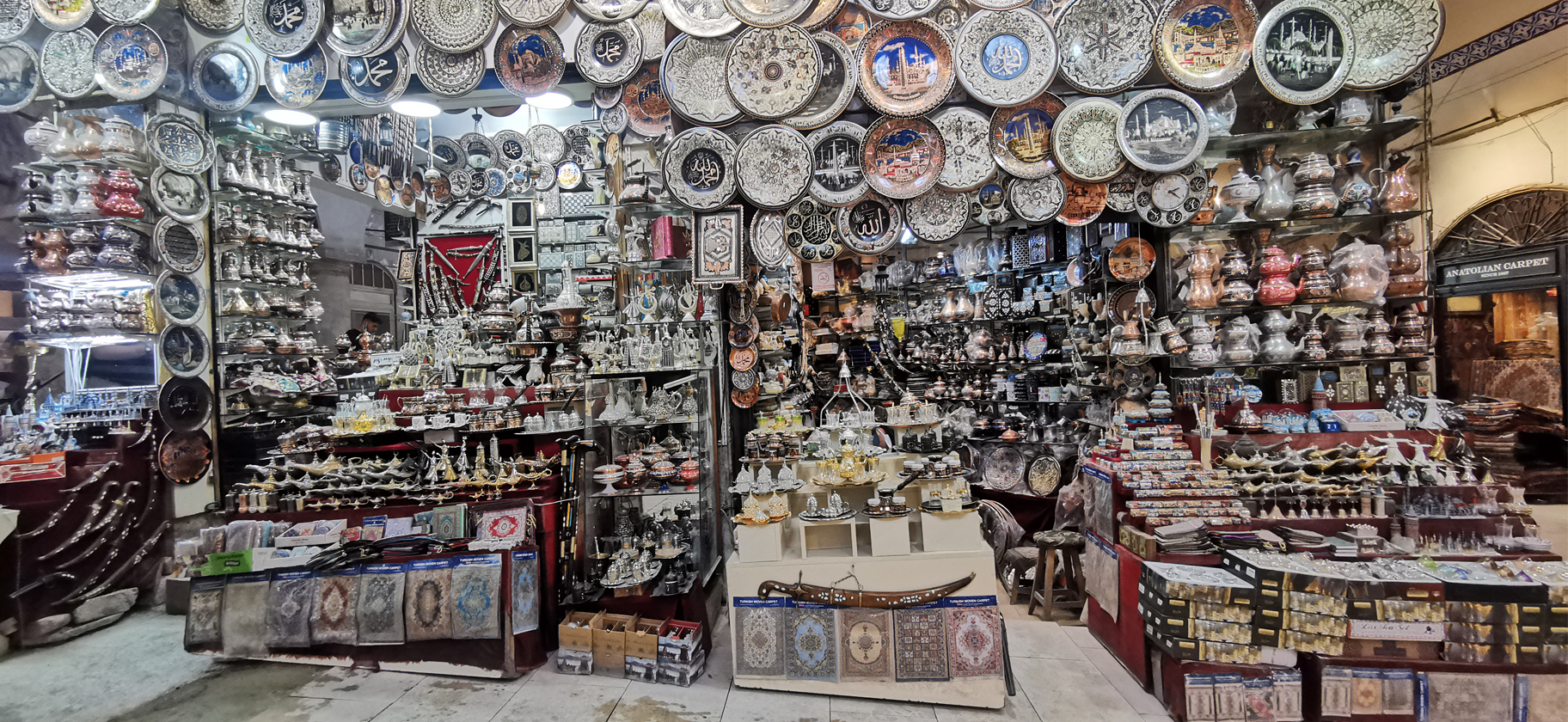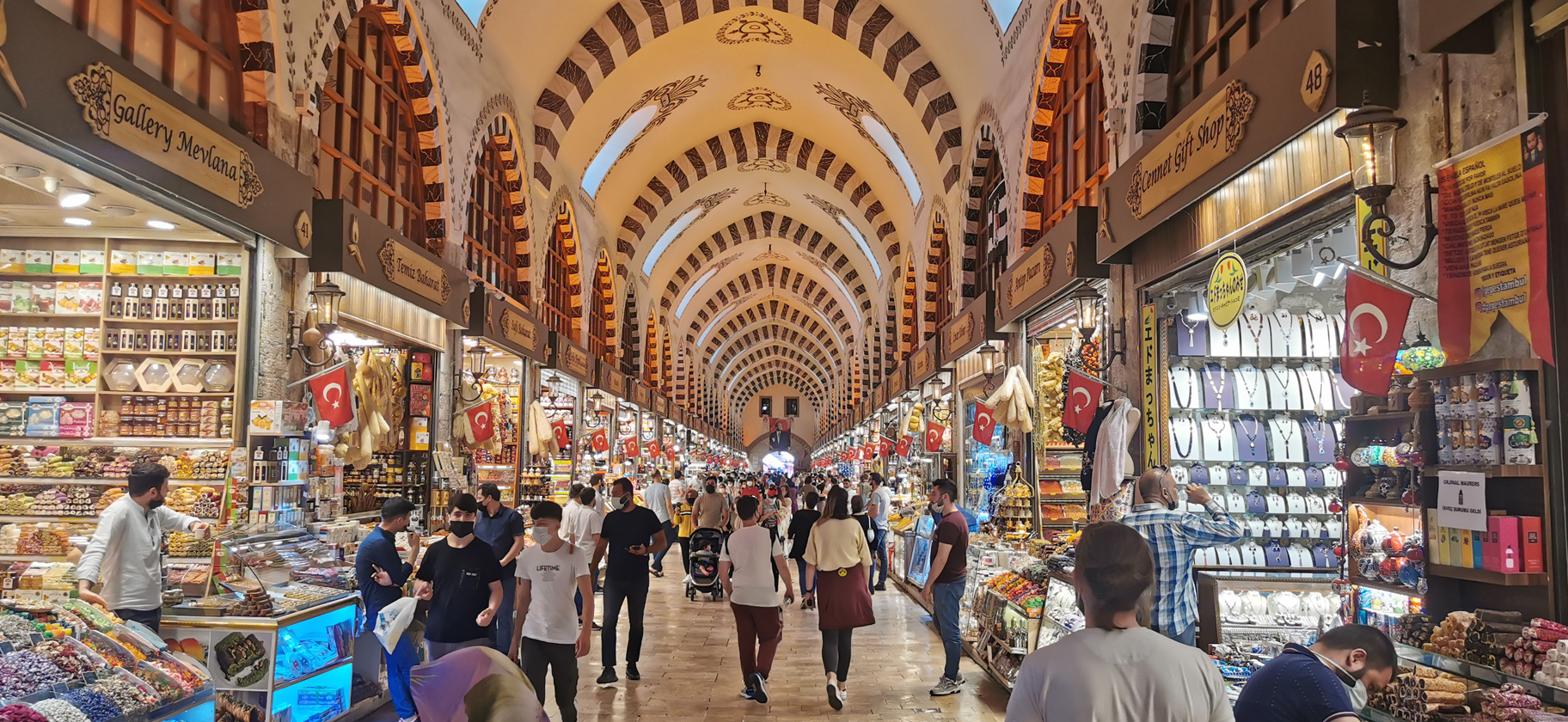The Scent of Apple Tea

Istanbul residents scurried out into the streets on a Monday morning after the heavy hand of government had kept all but the most essential workers indoors over the weekend. Up the hill from the Sultanahmet and across the bridges from Galata and Karaköy, thousands flocked into the Eminönü neighbourhood in Fatih, past security and health inspection, through the old wooden gates into the Grand Bazaar.
For more than five centuries, since the Ottoman conquest of Constantinople, the Grand Bazaar has stood at the centre of trade between Europe and the Far East. It has represented the economic heart of the modern world through which goods have flowed and circulated across the continents for generations. It is one of the most visited places on Earth and remains a thriving centre of Turkish life where hundreds of thousands of tourists and locals congregate every day. With over 4,000 shops within the walls of the Bazaar, as well as countless stores and shopfronts and small restaurants swelling outward for several kilometres to the banks of the Golden Horn and the Sea of Marmara, the pace of exchange and trade is as frantic here as in any souk or shopping mall from Los Angeles to Tokyo.
I had the privilege to visit Turkey in 2003 and it has captured my heart and my imagination ever since. Any visit to Istanbul inevitably includes a stay in the old city close to some of the most renowned and recognizable buildings in the world including the Hagia Sofia, Topkapi Palace and the Blue Mosque.  The Eminönü neighbourhood is a jumble of winding streets and the Bazaar, at its heart, is a closed structure made up of a series of plaster-covered stone archways laid out in a grid. In 2003, the Turkish mint had gone through a period of rapid inflation and one US dollar was equal to about 1 million Turkish Lira. It was common for shopkeepers to stand on boxes in the Bazaar screaming out their sales: “Bir, bir, bir! Mil-yon! Mil-yon! Mil-yon!”. The interactions of exchange were rapid and intense. Every shopkeeper kept close to their wares and looked passersby in the eye. As someone from a faraway land, I stood out and absorbed a lot of attention. Interactions between shopkeepers and foreigners were much slower, more intense, and always accompanied by a cup of sweet apple tea.
The Eminönü neighbourhood is a jumble of winding streets and the Bazaar, at its heart, is a closed structure made up of a series of plaster-covered stone archways laid out in a grid. In 2003, the Turkish mint had gone through a period of rapid inflation and one US dollar was equal to about 1 million Turkish Lira. It was common for shopkeepers to stand on boxes in the Bazaar screaming out their sales: “Bir, bir, bir! Mil-yon! Mil-yon! Mil-yon!”. The interactions of exchange were rapid and intense. Every shopkeeper kept close to their wares and looked passersby in the eye. As someone from a faraway land, I stood out and absorbed a lot of attention. Interactions between shopkeepers and foreigners were much slower, more intense, and always accompanied by a cup of sweet apple tea.
I was young and did not understand the custom that an invitation of apple tea was an invitation to buy.
“Would you like some tea?” the shopkeepers would ask.
“I’m not shopping,” I would reply.
“Shopping? What shopping?” they would scoff as if insulted. “I ask if you want tea? No shopping. Is free!”
Almost as a gesture of politeness, I would consent and be promptly brought a small glass of warm and sweet-smelling apple tea with heaps of sugar to share with my host.
“Where are you from?” they would ask.
“I am from Canada.”
“Ahhhhh, Canada! Very good! Good tea?”
“Yes, it’s delicious.”
“So, you like my shop?”
“Yes, it’s a very nice shop. You should feel very proud.”
“Tell me what you like in my shop.”
“It all looks very nice. It’s all very impressive.
The shopkeeper would turn to his inventory and pull an item from a shelf to show me. He would explain its origins and go into great detail about its quality. Even without asking the price, he would mention that if it was something that I liked that he could give me a special price and I would have to remind him that I was not shopping.
“No, no!” he would reply. “You say before you no shopping. But if you like it I can give you special price. If you like something, you let me know. No shopping. No, no, no! No shopping. If you like something, you say you like something. Is okay. You say something. You let me know.”
This manner of interaction became so common during my visit to Turkey that, anytime I felt like having tea, I would venture out to the shops and wait to be invited in. Often I would buy a small trinket and simply negotiate the price down to a million lira as a way to pay for the tea and thank the shopkeeper for the invitation. Haggling was also a part of the custom. Throughout the Bazaar and in front of shops all through Istanbul and the rest of Turkey, apple tea was kept in large barrels and left out on display. Every 50 metres was someone with a silver plate on their way to somewhere to deliver tea and at every shop was a shopkeeper with a warm cup of apple tea in hand. I must have averaged 3 cups of apple tea every day. Apple tea was so ubiquitous that the streets smelled of it and the body would become accustomed to that smell. After a while, you would only notice it if you travelled down to the Bosphorus and then back again. But if you spent enough time in and around the shops, that scent of apple tea just became the smell of the air and the smell of life in Turkey.
 The Bazaar is a feast for the senses with every manner of tradeable good on display and heaped upon one another: Every colour of silks and pashminas from the far east; an endless array of hand-painted serving trays and tea sets made of brass and copper; hand-carved chess sets and backgammon boards; piles of handwoven rugs from Egypt, Persia, the Caucasus, and as far away as India; mountains of hand-cut rolls of Turkish delight; barrels of spices from throughout the Orient – turmeric, coriander, cinnamon, anise, cardamom, cumin, nutmeg, and saffron; jewelled pewter bowls, cups, pots and dishware; laces and satins; gold chains and amulets; glowing rubies, emeralds and amethysts; shimmering diamonds, garnets and pearls clinging to chains of woven strands of gold; cotton and linen robes, hijabs, niqabs and burkhas; silk kilims; blown glass vases and pots; handmade ceremonial daggers, swords and sheaths; piles of pistachios, peanuts, dried fava beans, and dehydrated apricots; wicker baskets and wooden kitchen utensils; heaps upon heaps of dried dates and figs; coffee pots made from tin and copper; replica football jerseys from every major club across Europe; beaded bracelets; sun glasses; wood carvings and antique furniture; gilded dangling lanterns; plastic toy guns, train sets and kites; hand-painted ceramics kilned on the shores of the Kizilirmak river; nargile pipes and various types of flavoured tobacco; hand-sewn pillows and cushion covers; acoustic guitars, ouds, wood flutes, shakers, and tambourines; handbags and hats – there is no shortage of things to buy at the Grand Bazaar and all of them were still available and adding to it all the trappings of modern society like cell phones, accessories, covers, pop-sockets, and the new big seller: covid masks.
The Bazaar is a feast for the senses with every manner of tradeable good on display and heaped upon one another: Every colour of silks and pashminas from the far east; an endless array of hand-painted serving trays and tea sets made of brass and copper; hand-carved chess sets and backgammon boards; piles of handwoven rugs from Egypt, Persia, the Caucasus, and as far away as India; mountains of hand-cut rolls of Turkish delight; barrels of spices from throughout the Orient – turmeric, coriander, cinnamon, anise, cardamom, cumin, nutmeg, and saffron; jewelled pewter bowls, cups, pots and dishware; laces and satins; gold chains and amulets; glowing rubies, emeralds and amethysts; shimmering diamonds, garnets and pearls clinging to chains of woven strands of gold; cotton and linen robes, hijabs, niqabs and burkhas; silk kilims; blown glass vases and pots; handmade ceremonial daggers, swords and sheaths; piles of pistachios, peanuts, dried fava beans, and dehydrated apricots; wicker baskets and wooden kitchen utensils; heaps upon heaps of dried dates and figs; coffee pots made from tin and copper; replica football jerseys from every major club across Europe; beaded bracelets; sun glasses; wood carvings and antique furniture; gilded dangling lanterns; plastic toy guns, train sets and kites; hand-painted ceramics kilned on the shores of the Kizilirmak river; nargile pipes and various types of flavoured tobacco; hand-sewn pillows and cushion covers; acoustic guitars, ouds, wood flutes, shakers, and tambourines; handbags and hats – there is no shortage of things to buy at the Grand Bazaar and all of them were still available and adding to it all the trappings of modern society like cell phones, accessories, covers, pop-sockets, and the new big seller: covid masks.
Returning to the Bazaar on this particular Monday afternoon, I noticed that some things had changed. Despite the pandemic, the streets were still packed with locals and visitors shuffling elbow to elbow through narrow passageways but the pace of sale and the intensity of commerce had quieted. In 2003, the Bazaar was a finished product but now, like everywhere I had visited since the pandemic began, large swathes of the structure were under renovation. Maybe it was the mood of the people or the downturn in tourism but something about the Bazaar felt eerily sedate.
Walking through the catacombs of the Bazaar I was free to browse without entering any of the shops. Not once was I bothered by a shop owner keen to know what I had come to the Bazaar to buy and how they could give me a special price. In fact, there were many shops now manned by a lone junior attendant who kept their attention firmly fixed on their cellphone and it was as if I and the hustle and bustle of the Bazaar did not even exist. Any shop that offered food now had samples out on display and shops selling wares had price tags affixed to almost every item. Older attendants, with little interest in their cellphones, stood by the door of their shops with arms folded in silence.
In 2005, after years with the dubious distinction of being the world’s least valuable currency, the Turkish Lira underwent a revaluation. Now trading anywhere from 6 to 9 Lira per dollar, the words in Turkish to announce deals did not have the same ring to them as the “mil-yon!” of 2003. Shopkeepers did not stand on boxes to see over the crowds and scream out their sales and instead gathered in small corners of the Bazaar just to chat and smoke cigarettes. Thick wads of cash continued to change hands but the urgency was gone.
Ever since the formation of the European Union, Turkey has been trying to get in and grab a slice of the economic benefits while continually being denied admittance on the grounds that the values of the Turkish people do not reflect those of Europe. Despite it sitting at the European continent’s doorstep, my impression of Turkey had always been that in many ways it was almost more Middle Eastern than the Middle East and I loved it for that. Fast forward to today and the Grand Bazaar had undergone a transformation aimed at preserving the history of the Bazaar while modernizing it into a streamlined and structured amusement park that would give any corporate bureaucrat the jollies.
I walked for hours through Eminönü trying to latch onto the emotions I was feeling at recognizing how this one particular iconic Istanbul experience had evolved. I watched as local Turks went about their shopping day collecting the items they needed and how they and shop owners interacted. I watched the ice-cream sellers tapping rhythmically on their metal bins and putting on their show for tourists. I observed how tourists scanned the items on display hanging from every corner from floor to ceiling as they pointed and smiled and took selfies. Almost 20 years since my first visit, the Grand Bazaar continued to offer a life-altering experience that was uniquely Turkish. But something felt like it was missing and I was consumed with a feeling of pity for those who would never know what it was that had disappeared.
Not once was I addressed directly and looked in the eye by a shop owner. Not once was I invited into their shop to look around. Not once did I have to explain why I was there or haggle over the price of a cheap bracelet. Not once was I offered apple tea. Not once did I see a barrel of apple tea even in a tea shop. Teas on display now had labels describing their blends with names like cleansing, focus, calming, and energy, with long lists of the dried herbs and leaves that had been mixed together to create them. I began to notice that the Grand Bazaar was no longer a locus upon which the world was introduced to the culture and values of Turkey but a location where tourists, Turks, ex-pats, and influencers were woven together into a symbol of the modern world. The Grand Bazaar continues to captivate and pique the imagination of anyone who enters but it has been simplified and its hallways no longer smell of apple tea but of progress and modernity.
Once upon a time, it was daunting to navigate the Bazaar where the hustle was constant. Visitors needed to keep their heads on a swivel and their wits about them but also their noses up and downwind to take in that sweet-smelling apple tea wafting off of the barrels stewing in the sun at every corner. The smell of apple tea is a memory that channels itself directly from source to cerebellum defining the frame of the Turkish experience even if Turkey has moved on.
